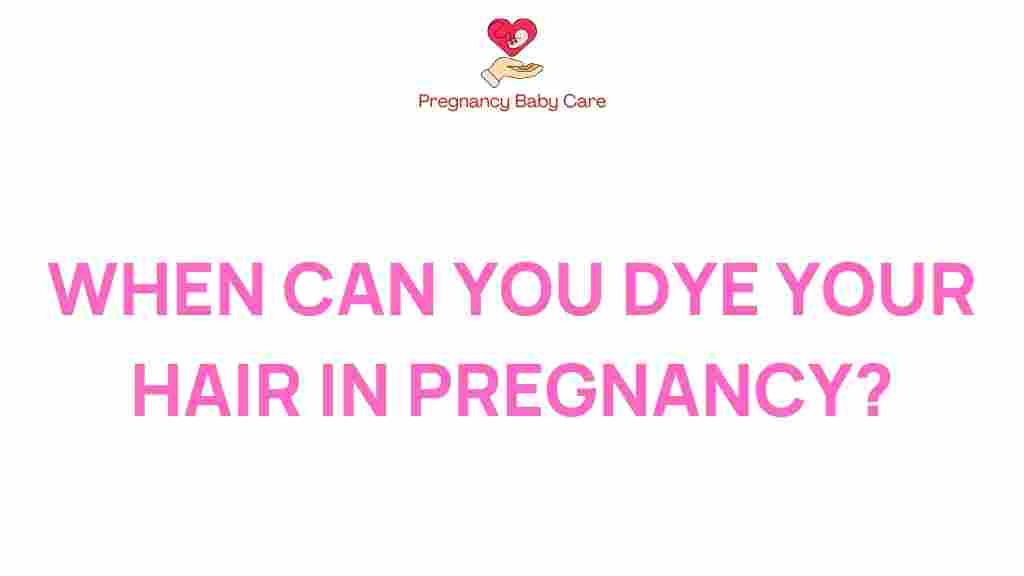Timing Your Hair Dye: What Expecting Mothers Need to Know
Pregnancy brings about a multitude of changes in a woman’s body, and for many expecting mothers, the desire to maintain their appearance can lead to questions about hair dye. With a focus on health concerns, timing, and safety, this article aims to provide crucial information for pregnant women considering hair dye during their pregnancy journey.
Understanding Hair Dye and Chemicals
Hair dye products can contain a variety of chemicals, some of which may raise concerns for pregnant women. The most common chemicals found in hair dye include:
- Ammonia
- Hydrogen peroxide
- PPD (p-phenylenediamine)
- Resorcinol
While many of these chemicals are generally considered safe in small amounts, expecting mothers should be cautious as their bodies undergo hormonal changes that can affect skin sensitivity and overall health. It’s essential to understand how these chemicals might impact both the mother and the baby.
Timing Your Hair Dye During Pregnancy
When it comes to timing your hair dye, it is critical to consider the trimesters of pregnancy:
- First Trimester: The first trimester is a crucial period of fetal development. Many healthcare providers recommend avoiding hair dye during this time due to the potential absorption of chemicals through the skin.
- Second Trimester: As the pregnancy progresses and the risk of miscarriage decreases, some studies suggest that dyeing hair during the second trimester may be safer. However, it’s still advisable to use caution and opt for products that are ammonia-free or contain natural ingredients.
- Third Trimester: In the third trimester, while most health risks are reduced, many women may experience heightened skin sensitivity. This can lead to allergic reactions or irritation from hair dye products.
Health Concerns Related to Hair Dye in Pregnancy
Expecting mothers should be aware of potential health concerns associated with hair dye:
- Skin Sensitivity: Hormonal changes can lead to increased skin sensitivity, making it crucial to conduct a patch test before applying any hair dye.
- Allergic Reactions: Some women may experience allergic reactions to hair dye during pregnancy, even if they have used the product without issues in the past.
- Fetal Development: Although research is limited, some studies have raised concerns about the potential effects of hair dye chemicals on fetal development.
Step-by-Step Process for Dyeing Hair Safely During Pregnancy
If you decide to dye your hair during pregnancy, consider the following steps to minimize risks:
- Consult Your Healthcare Provider: Before proceeding, discuss your plans with your doctor, especially if you have any pre-existing conditions or concerns.
- Choose the Right Product: Opt for hair dyes that are free from harmful chemicals. Look for products labeled as organic or natural.
- Conduct a Patch Test: Always perform a patch test at least 48 hours before applying the dye to your entire head. This will help you check for any allergic reactions.
- Use Ventilation: Ensure you are in a well-ventilated area while dyeing your hair to minimize inhalation of fumes.
- Avoid Scalp Contact: Try to apply the dye only to the hair strands and avoid direct contact with the scalp to reduce the absorption of chemicals.
- Limit Frequency: Consider limiting the frequency of hair dyeing during pregnancy to reduce exposure to chemicals.
Troubleshooting Tips for Common Hair Dye Issues
When dyeing your hair during pregnancy, you might encounter some challenges. Here are some troubleshooting tips:
- If You Experience Allergic Reactions: If you notice redness, itching, or swelling after dyeing your hair, wash the dye out immediately and consult your healthcare provider.
- If the Color Doesn’t Turn Out as Expected: Hair can behave differently during pregnancy due to hormonal changes. If you’re not satisfied with the color, consider waiting a few weeks before trying again.
- If You Have Skin Sensitivity: If your scalp feels irritated, consider using a gentler formula or a temporary rinse product instead of permanent dye.
Conclusion: Making Informed Decisions About Hair Dye in Pregnancy
Timing your hair dye during pregnancy is an important decision that requires careful consideration of health concerns, safety, and the potential effects on your baby. By understanding the risks associated with hair dye chemicals and following the above guidelines, expecting mothers can make informed choices about their hair care routine.
Always prioritize your health and consult with healthcare professionals if you’re unsure about using hair dye during pregnancy. With the right precautions, you can maintain your hair while ensuring the safety of you and your baby.
For more information on safe beauty practices during pregnancy, visit this resource.
And remember, it’s always best to listen to your body and make choices that feel right for you. Your health and that of your baby are paramount!
This article is in the category Pregnancy and created by PregnancyBabyCare Team
